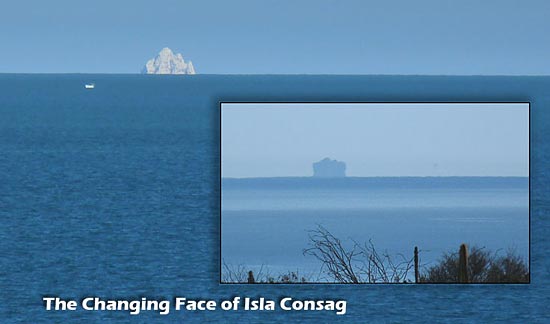
As you throw your towel down on the sand,
anticipating a loose and relaxing afternoon in the sun
on one of San Felipe's blonde beaches, cast your gaze
eastward and you'll likely witness one of the many masks
of Isla Consag, the 296 foot guano-covered rock that rises
out of the sea twenty two miles off the town's shoreline.
The island seems to have more disguises
than Lon Chaney, more impressions than Rich Little. Atmospheric
tricks keep the rock in a perpetual morphic dance, at
one instant showing its circus midget stature while an
hour later it looms out of the sea like an NBA star. The
next day it draws a mantle of mysticism around itself
and appears as a floating city in the sky. Then the following
week it seems content to be, for a while, simply itself.
A furrowed rock edifice, crusted white with bird droppings.
Warm and cool air, wind, humidity and refraction
all come into play to make San Felipe the eyepiece end
of a kaleidoscope that rolls the myriad images of Isla
Consag against the snap line of the horizon. It's the
entertainment of a master hand manipulator throwing shadows
on a wall.
In a way, the masks of Consag are somewhat
like mirages. Mirage is a word that traces it origin to
the French verb se
mirer: to be reflected. Actually, refraction is
the active ingredient in a mirage.
The plasticity and shape-shifting showmanship
of mirages are totally dependent on atmospheric conditions.
When a Consag appears to change position, it is because
light reflected from the rock travels through layers of
warm and cool air and, because of the layers differing
densities, becomes bent or refracted upward or downward
making the island appear to an observer at a certain relation
to the light, either above or below its true position.
Mirages come in different flavors. While
driving on a hot day, have you ever seen water sitting
on the highway in the distance? This kind of mirage is
called an inferior image. What you're actually
seeing is a reflection of the sky. Light rays are bent
toward your eyes by the hot air above the pavement sitting
just below a layer of cooler air. The proverbial lake
in the desert is formed in the same manner (which can
be quite an aid to real estate salesmen). The image of
the sky is refracted to appear at ground level, and because
of its blueness, seems quite aquatic.
Another kind of mirage, which applies to
the Isla Consag, commonly occurs over water or ice. It
is called a superior image and takes it
process from light rays being refracted downward, making
an image appear to float in the air. Also, objects on
the other side of the horizon line, not normally seen,
may become visible on or above the horizon. This phenomena
is sometimes called looming and can magnify distant
objects so they appear closer than they actually are.
A notable kind of superior image is something
called a fata morgana. This atmospheric trick presents
the image as a floating city or castle. It requires a
particular series of cold and hot air layers sitting close
to the surface of the water. The layers superimpose recurrent
images on top of each other. These stacked images can
often appear as skyscrapers, and hence the city affect.
|